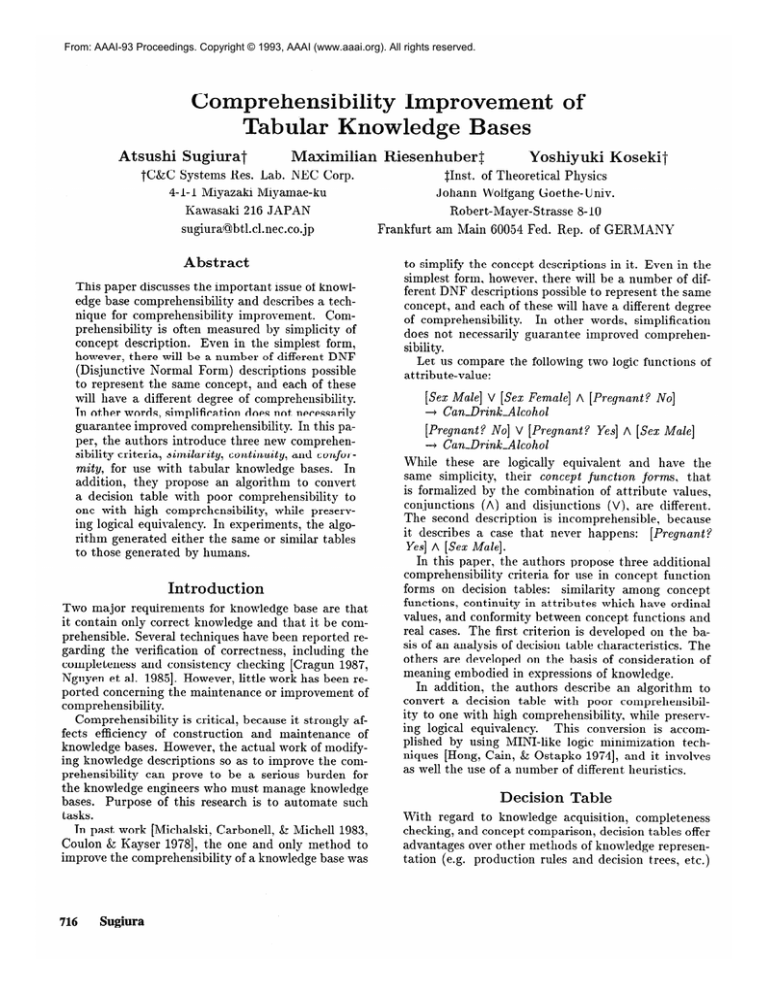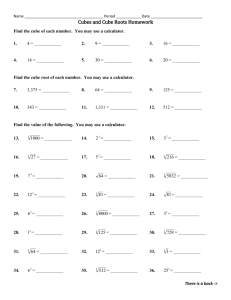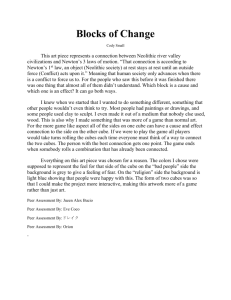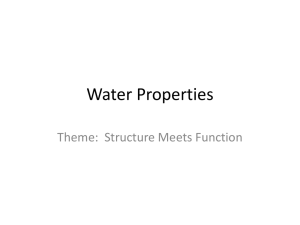
From: AAAI-93 Proceedings. Copyright © 1993, AAAI (www.aaai.org). All rights reserved.
Comprehensibility
Improvement
Tabular Knowledge Bases
Atsushi
Sugiurat
tC&C
Maximilian
Systems Res. Lab. NEC Corp.
4-l- 1 Miyazaki
Kawasaki
Miyamae-ku
216 JAPAN
sugiuraQbtl.cl.nec.co.jp
Abstract
This paper discusses the important. issue of knowledge base comprehensibility
and describes a technique for comprehensibility
improvement.
Comprehensibility
is often measured by simplicity of
concept description.
Even in the simplest form,
however, there will be a number of different DNF
(Disjunctive
Normal Form) descriptions possible
to represent the same concept, and each of these
will have a different degree of comprehensibility.
In other words, simplification does not necessarily
guarantee improved comprehensibility.
In this paper, the authors introduce three new comprehensibility criteria, similarity, continuity, and conformity, for use with tabular knowledge bases. In
addition, they propose an algorithm to convert
a decision table with poor comprehensibility
to
one with high comprehensibility,
while preserving logical equivalency. In experiments, the algorithm generated either the same or similar tables
to those generated by humans.
Introduction
Two major requirements for knowledge base are that
it contain only correct knowledge and that it, be comprehensible. Several techniques have been reported regarding the verification of correct,ness, including the
completeness
and consistency checking [Cragun 1987,
Nguyen et al. 19851. However, little work has been reported concerning the maintenance or improvement of
comprehensibility.
Comprehensibility
is critical, because it strongly affects efficiency of construction
and maintenance
of
knowledge bases. However, the actual work of modifying knowledge descriptions so as to improve the comprehensibility
can prove to be a serious burden for
the knowledge engineers who must manage knowledge
bases. Purpose of this research is to automate such
tasks.
In past work [Michalski, Carbonell, & Michell 1983,
Coulon & Kayser 19781, the one and only method to
improve the comprehensibility
of a knowledge base was
716
Sugiura
Riesenhubert
of
Uoshiyuki
SInst. of Theoretical
Johann Wolfgang
Kosekit
Physics
Goethe-Univ.
Robert-Mayer-Strasse
8-10
Frankfurt am Main 60054 Fed. Rep.
of GERMANY
to simplify the concept descriptions in it. Even in the
simplest form, however, there will be a number of different DNF descriptions possible to represent the same
concept, and each of these will have a different degree
of comprehensibility.
In other words, simplification
does not necessarily guarantee improved comprehensibility.
Let us compare the following two logic functions of
attribute-value:
[Sex Male] V [Sex Female] A [Pregnant?
--+ CanDrinkAlcohol
[Pregnant? No] V [Pregnant?
+ CanDrink-Alcohol
No]
Yes] A [Sex Mate]
While these are logically
equivalent and have the
same simplicity,
their concept function forms, that
is formalized by the combination
of attribute values,
conjunctions
(A) and disjunctions
(V), are different.
The second description is incomprehensible,
because
it describes a case that never happens:
[Pregnant P
Yes] A [Sex Male].
In this paper, the authors propose three additional
comprehensibility
criteria for use in concept function
forms on decision tables:
similarity among concept
functions, continuity in attributes which have ordinal
values, and conformity between concept functions and
real cases. The first criterion is developed on the basis of an analysis of decision table characteristics.
The
others are developed on the basis of consideration
of
meaning embodied in expressions of knowledge.
In addition, the authors describe an algorithm to
convert a decision table with poor comprehensibility to one with high comprehensibility,
while preserving logical equivalency.
This conversion is accomplished by using MINI-like logic minimization
techniques [Hong, Cain, & Ostapko 19741, and it involves
as well the use of a number of different heuristics.
Decision
Table
With regard to knowledge acquisition,
completeness
checking, and concept comparison, decision tables offer
advantages over other methods of knowledge representation (e.g. production rules and decision trees, etc.)
Table 1: Comprehensible
expression
for bond selection.
Table 2: Incomprehensible
Materla..
Usage
Hondmg-area
Paper
Lea- Plas- Nor- indus- Large Small
ther tic
ma1 trial
[Cragun 1987, Koseki, Nakakuki, SCTanaka 19911.
A decision table represents a set of concept functions, expressed in DNF. This construct enables the
handling of disjunctive concepts which have multiplevalue attributes.
Each concept function consists of a
number of disjuncts, called cubes. Each cube consists
of a set of values for an attribute.
The union of the
vertices in logic space, covered by concept function, is
called a cozier for the concept.
An example knowledge base is shown in Table 1.
Here, each row forms a cube, and a set of cubes for the
same concept name forms a a concept function.
For
example, the concept function for Bond-B consists of
three cubes, and each cube consists of t.hree attributes.
In a cube, the values specified by the circle (0) in an
attribute are ORed, and all attributes are ANDecl to
form the cube. Don’t-Care
attributes are designated as
an attribute with all OS. A min-term is a cube which
has only one 0 in every attribute.
The decision table facilitates the comparison of different concepts, due to the following reason. Concept
comparison means comparing the values of all the attributes which define concepts.
In this context, the
decision tables, in which description of the same attribute is represented in the same columns and concepts are represented by all attributes, can facilitate
concept comparison.
In other knowledge represent ations, for example in the production
rules, the same
attribute name appears in various positions of each
rule, and concepts are represented only by attributes
that are necessary to define concepts.
This disturbs
easy comparison of attribute values.
This advantage is critical for the knowledge base constructions, because, in the classification problems, it is
essential to compare and to classify the concepts which
have the same cover.
Comprehensibility
Criteria
This section presents four criteria for knowledge base
comprehensibility.
One is simplicity of concept deThe
scription,
which is the conventional
criterion.
other three are concerned with concept function forms.
Three new criteria are a reflection of the great influence
of the concept function forms on its comprehensibility.
The second criteria employs general rules to facilitate the comparison
of different concepts, whereas the
ther
expression
tic
ma1
for bond selection.
trial
last two require some background knowledge,
characteristics of attributes and their values.
Table
which is
Size
Preference criteria for human comprehensibility
are
commonly based on the knowledge description length
(for example,
[Michalski, Carbonell, St Michell 1983,
Coulon & Iiayser 19781).
Some
inductive
learning algorithms [Michalski, Carbonell, & Michell 1983,
Quinlan 19861 reduce the knowledge base size to obtain simple knowledge expressions.
As the conventional criteria, the aut,hors define table size as one of the comprehensibility
factors. Since
the number of attributes to define concepts is fixed in
the decision tables, table size can be measured by the
number of cubes.
Similarity
among
CJoncept Functions
When comparing different concepts, it is desirable to
be able to easily ascert,ain common and different features in each concept.
This requires high similarity
among concept functions.
Table 1 and Table 2 are example knowledge bases for
a bond selection problem.
They have the same cover
and the same table size, but their concept function
forms (cube shapes) are different.
In this example,
Table 1 is better than Table 2, for the following reasons.
First, compare Bond-B with Bond-A. -In the first,
cube (Bond-A) and the second cube (Bond-B) in Table 1, their forms are exactly the same.
Using Table 1, the intersection of the two concepts in logic
space can be determined by looking at just two cubes,
whereas, using Table 2, this would require considering
four cubes.
Next, compare Bond-B with Bond-C. In the third
cube (Bond-B) and the fifth cube (Bond-C) in Table 1,
descriptions of attributes Usage and Bonding-area are
the same; only those of attribute Material are different. This makes it easy to see that these two concepts
are discriminated by attribute Material. On the other
hand, in Table 2, descriptions of most of the attributes
are different, making the common and different features unclear.
Overall, comprehensibility
of Table 1 arises from the
high similarity among the concept function forms: the
Rule-Based
Reasoning
717
Table 3: Comprehensible
Approval.
expression
Schoolrecord
tiood l’oor
Student
earn?
Yes
No
Parent-income
(ten
thousand
-6
6- (
0
Approved
0
x0x000x
Approved
X
Approved
X
oxoooxx
0
0
Not-approved
0
xoxxx
Not-approved
X
oxoxxoo
Not-approved
X
0
x
0
x
!
0
8-
x
x
0
x
x-
x
0
0
0‘
cubes and the third and the fifth
Continuity
in Attributes
Ordinal Values
which have
In many knowledge bases, attributes with ordinal values are expressed
by a range of values (for example,
material which is harder than aluminum should be
shaped by grinder-A). Therefore, high continuity of OS
in such attributes leads to high comprehensibility.
Two example knowledge bases for a scholarship approval are shown in Table 3 and Table 4, which have
the same cover and the same table size. Values of the
attribute Parent-income
are ordinal values.
These examples implicitly epbody the meaning that
students whose parent income is low are granted scholarship, which can be seen clearly in Table 3. By contrast, the first cube in Table 4 shows that some students are granted scholarships, if the parent income is
less than $60,000 or more than $80,000.
This gives
the initial impression that anyone with an income of
$60,000-80,000
can not be approved.
By examining
other cubes this can be seen to be false, but this is
time-consuming;
Table 3 is preferable to Table 4.
Conformity
between
and Real Cases
Concept
Sugiura
Student
earn?
Yes 1 No
Not-approved
X
000x
Not-approved
X
ooxxo
for Scholarship
Parent-income
(ten
thousand
dollars)
-6 1 6-‘/ 1 ’L-8 1 8-
x
0
x
0
x
tribute Exam and the constrained attribute Makeupexam: taking the makeup exam depends on the result
of the exam.
In this example, Table 5 is more comprehensible
than Table 6, because of the conformity bet,ween concept functions and the real cases. In the first cube in
Table
6, a case
examination
makeup
that
never
happens
is described:
result is not less than 60 points
examination
result
an
and the
is less t,han 80 points.
Ta-
ble 5, however, represents only the real cases.
In general, the precondition
attributes should not
be Don’t,-Cares,
if the constrained attributes are not
Don’t-Cares.
Table 5: Comprehensible
expression
for Credit Earning.
Lxam
>BU
<tju
Pass
Pass
Fail
0
X
0
X
0
X
Makeup-exam
>8U
<8U
0
0
0
X
X
0
Table 6: Incomprehensible
expression
for Credit Earning.
Exam
>BU
<6U
-
Functions
In some knowledge bases, there is a dependency
relationship between the attributes, which the authors
can divide into precondition and constrained attributes.
Whether the constrained attribute relates to concept
definition or not depends on the values of the precondition attribute. In such a situation, the positions of the
Don’t-Cares
are critical, because cases that never happen in the real world may be described in knowledge
bases.
Other knowledge bases relating to an earned credit
at a university are shown in Table 5 and Table 6; they
have the same cover and the same table size. These examples implicitly embody the meaning that only students who failed the first exam are eligible to take
the makeup exam. There exists an attribute dependency relationship
consisting of the precondition
at-
718
Schoolrecord
Good1 Poor
dollars)
i-8
expression
xxo~ooo
Approved
first and the second
cubes.
Table 4: Incomprehensible
Approval.
t
for Scholarship
Pass
Pass
Fail
0
0
0
X
0
X
Makeup-exam
<8U
->8U
X
0
0
X
X
0
Algorithm
Figure 1 shows an algorithm to improve t.he comprehensibility of a decision table. It convert)s a table with
poor comprehensibility
to one with high comprehensibility,
while
preserving
logical
equivalency.
Table conversion
is accomplished
by the techniques used in logic minimization
algorithm
MINI:
disjoint sharp operation,
Expansion,
and Reduction
[Hong, Cain, & Ostapko 19741. In these operations,
attributes are required to be ordered, and this order
affects concept function forms in a resultant, table. The
proposed algorithm first determines the attribute order a, where cr is a list of attributes that specifies the
I Notation
attribute (1 5 i 5 n)
list of the cubes for jth concept (1 5 j 5 m)
precondition
attribute on attribute dependence relationship
constrained attribute on attribute dependence relationship
set of attributes which have ordinal values
begin
i
4
5
6
ii
9
10
/* Determination
of attribute order */
Calculate n; (1 5 i 2 n) by (U @ (U @C,))
with attribute order (a;, a
L;,tl t list of a; E S sorted in Increasing order of n;
List2t list of ai 4 S sorted in increasing order of ni
0 i- connect L;,t2after List1
for all (p, q) do
if q is placed after p on o
then
d t list which q is moved to previous position of p
endif
endfor
/* Modification
of concept functions */
for Cj(1 5 j < m) do
Cj + (U @ (U @ Cj)) with o
endfor
Expand and Reduce the cubes with CT
Figure 1: Algorithm
for improving
order, by some heuristics (in Lines 2-10, Fig. l), and
next modifies the concept function forms by MINI’s
techniques (in Lines 11-14, Fig. 1).
The main difference between MINI and the proposed
algorithm is heuristics to determine the attribute order
While the heuristics in MINI alin each algorithm.
gorithm are mainly for reducing t,he number of cubes,
those in the proposed algorithm are for improving comprehensibility.
For the explanation of heuristics here, consider a decision table constructed
solely by min-terms like Table 7. The heuristics for attribute order 0 is due to the
three out of four comprehensibility
criteria:
1. Table
size.
A small-size table can be obtained by merging as
many min-terms as possible.
The algorithm prescans t,he table and examines the merging ability of
each attribute, measured by n;, where the number of
cubes after merging min-terms for all concepts only
on attribute a;. For example, ‘T?Bonding--area= 7, as
shown in Table 8. Also, nn/laterial = 10, nusage = 8.
Att.ributes are ordered in increasing order of ni (in
Lines 2-4, Fig. 1). The algorithm merges the cubes,
one atkibute at a time, in this order. In other words,
first the cubes are merged on attribut,e with high
merging ability and last on attribute with low ability.
Table 1 is generated by merging the cubes in Table 7
Usage, Material).
with the 0 = (Bonding-area,
2. Continuity
values.
in attributes
which
have
ordinal
Attributes with ordinal values are placed at the beginning of cr (in Line 5, Fig. 1). Cubes are first
comprehensibility.
merged on those attributes,
generating the maximum number of OS in those attributes.
As a result, high continuit#y of OS in those attributes can
be achieved.
3. Conformity
real cases.
between
concept
functions
and
Attribute order is changed so that the constrained
attribute is placed before the precondition atetribute
(in Lines 6-10, Fig. 1).
This change prevents
Don’t-Cares
being generated in the precondition
attribute, because cubes are merged on the constrained
attribute
before considering
the precondition
attribute. In the example of knowledge bases for credit
earning, Table 5 and Table 6 are generated by c =
(Makeup-exam,
Exam.) and CT = (Exam., Makeupexam,), respectively.
After determining
the attribute order 0, concept
function forms are modified.
In the modificat,ion,
t,o
achieve high Similarity among concept functions, other
heuristics are applied.
4. Similarity
among
concept
functions.
High similarity can be achieved, when cubes for
many concepts are merged on the same attributes.
The algorithm merges the cubes in the same order
of attributes for all concepts.
If, in the early stage of merging, cubes are merged
on the attributes, in which the cubes only for the
specific concepts can be merged, then similarit,y becomes low. In Table 7, if first merged 011 Material,
cubes mainly for concept Bond-B can be merged.
Attribute order CT = (Material,
Usage, Bonding-
Rule-Based
Reasoning
719
Experimental
Area) leads to Table 2, whose similarity is low. However, it is expected that such merging would be prevented, because the cubes are first merged on the
attributes which many cubes can be merged (See
1.).
To evaluate concept function forms generated by the
proposed algorithm, the authors experimented
on 11
real knowledge bases. In addition, they evaluated table
size and computational
time, using 1 real knowledge
base and 24 artificial ones, which are quite large.
If all cubes in the given table were converted
to min-terms for the pre-scan and the modification,
the algorithm would take exponential
time.
To reduce this to a modest
amount
of computational
time, it uses disjoint sharp operation F @ G, where
F and G are lists of cubes (details are shown in
[Hong, Cain, & Ostapko 19741).
Concept
In the modification,
the following feature of the
@ operation is utilized: U @ G with g generates more
OS in the attribute placed in the earlier position of
a, where U is universe. This operation can generate
almost the same concept function forms, as merging
min-terms in the attribute order IT. However, since the
order of the cubes in Cj affects the number of cubes
generated by U @ Cj, the generated table may be redundant. To reduce the table size, cubes are Expanded
and Reduced, using the (T order (in Line 14, Fig. 1).
Table 7: Table constructed
only by min-terms.
1
Usage
IBonding-area
Material
Paper I Lea- 1k’las-1 Nor- I lndus- I Large I 5mail
ther tic
ma1
trial
Results
1
I
Function
forms
The proposed algorithm is based on MINI. However,
MINI’s goal is logic minimization,
not knowledge base
modification,
and the knowledge bases minimized by
MINI are incomprehensible.
To confirm the comprehensibility
of the generated
table, the authors experimented on 11 reaJ knowledge
bases, which have 3-7 attributes, 5-20 cubes, 2-6 conFour examples contain atcepts, and 6-20 columns.
tributes with ordinal values and attribute dependency
relationships.
Comprehensibility
is evaluated by comparing
the
concept function forms modified by a human with
those modified by the algorithm.
In seven examples,
concept functions produced by the algorithm exact,ly
corresponded
to those produced by a human. In the
other four examples, results were different, but they
were comprehensible
to humans.
This difference is mainly due to the limitation in the
algorithm:
it can only generate cubes which are mutually disjoint. Moreover, the difference might partly
be attributed to the heuristics for det,ermining the attribute order. If the calculated rzi values were equal
in some attributes, the algorithm would determine the
order arbitrarily; it is not guaranteed that expected
concept functions are obtained. This situation was observed in two knowledge bases.
Table Size
Bond-C
X
x-
0
0
x
0
X
Bond-C
X
x
0
0
x
X
0
Table 8: Table after merging min-terms
attribute Bonding-area.
Paper
Material
Leather
on
Usage
Bonding-area
Plas- Nor- Indus- Large Small
ma1 trial
tic
Experimental results on 24 artificial knowledge bases
showed that the algorithm performs logic minimization
well. These knowledge bases have 1 concept, 10 cubes,
30 attributes, and 120 columns.
In 21 knowledge bases, size of the generated tables
were exactly the same as that by MINI. However, in
the other three knowledge bases, MINI was able to
generate one or two cubes less than the proposed algorithm.
This arises from another limitation in the
algorithm: Don’t-Cares are collected in the specific attributes, placed in the early position of cr.
The algorithm was also evaluated on a real knowledge base for a grinder selection problem, which has
1023 cubes,
16 attributes,
and 222
158 concepts,
columns. In this experiment, the proposed algorithm
generated the same number of cubes as MINI.
Computational
Time
Pre-scan and modification of a table are based on the
disjoint sharp operation. However, it is difficult to estimate the exact cost for the disjoint sharp operation.
This is because the cost depends on the concept cover,
720
Sugiura
the attributes order, and the cube order in the rightside cube list of the @.
To confirm the feasibility of the algorithm, the authors experimented
on 24 artificial knowledge bases,
described in the previous subsection, with a 33 MIPS
work-station.
The tables were generated in 210 seconds
on an average , which is about 50 % of MINI.
The authors also experimented on a real knowledge
base for the grinder selection problem. The resultant
table can be obtained in 90 seconds (80 seconds by
MINI). This time is not too long and actually much
shorter than the time required for modification
by a
knowledge engineer.
Related
Work
Inductive learning algorithms, like ID3 [Quinlan 19861,
can also improve the comprehensibility
of concept functions.
However, the produced concept functions are
often incomprehensible,
because of the lack of background knowledge and the comprehensibility
criteria;
they only use the description length criteria implicitly.
From another viewpoint,
most induction algorithms
generate decision trees, not decision tables. Generated
decision trees may have a minimum number of nodes
and leaves. However, this does not mean a minimum
number of cubes.
EG2
[NziGez 19911 uses background
knowledge,
which is IS-A hierarchy of values, to simplify the decision tree and to obtain a more comprehensible
knowlHowever, EG2 requires much backedge expression.
ground knowledge for such simplification.
In the proposed algorithm, the only background knowledge required concerns the attribute dependency relationships
and the orderings of ordinal attribute values.
The orderings of the ordinal attribute values is used
in INDUCE [Michalski, Carbonell, & Michell 19831 to
generalize concepts. The proposed algorithm does not
generalize the concepts,
but produces the logicallyequivalent concept functions to those described by
knowledge engineers.
Conclusion
This paper presented new comprehensibility
criteria regarding
concept
function
forms, and an algorithm
for automatically
producing
comprehensible forms of concept functions.
This algorithm is
implemented
on an expert-system
shell DT, which
handles classification
problems on the decision table
[Koseki, Nakakuki, & Tanaka 19911; its usefulness has
been demonstrated in several real problems. Since the
concept functions on decision table format can be easily converted to the one on production
rule format,
this algorithm can be applied to the knowledge bases
constructed by production rules.
The new criteria are general ones, which can be applied to many knowledge bases. However, comprehensibility criteria differ according to people and domains,
and generated tables may not correspond exactly to
the tables expected by knowledge engineers. This disagreement, however, can be overcome by a knowledge
editor on DT.
Acknowledgement
The authors express their appreciation
to Takeshi
Yoshimura of NEC Corporation
for giving them the
opportunity to pursue this research.
References
[Cragun 19871 Cragun,B.J.
1987. A decision-tablebased processor for checking completeness and consistency in rule-based expert systems. International
Journals of Man-Machine
Studies 26( 5):3-19.
[Hong, Cain, & Ostapko 19741 Hong,S.J.;
Cain,R.G.;
and Ostapk0,D.L.
1974. MINI:A
Heuristic
Approach for Logic Minimization.
IBM Journal of Research and Development ~443-458.
[Coulon & Kayser 19781 Coulon,D.;
and
1978. Learning criterion and inductive
Pattern Recognition lO( 1):19-25.
Kayser,D.
behavior.
[Koseki, Nakakuki, & Tanaka 19911 Koseki,Y.;
Nakakuki,Y.; and Tanaka,M. 1991. DT:A Classification Problem Solver with Tabular-Knowledge
acquisition. Proceedings of Third International
Conference on Tools for Artificial Intelligence 156-163.
[Michalski, Carbonell, & Michell 19831
Michalski,R.S.;
Carbonel1,J.G.;
and Michel1,T.M.
1983. A Theory and Methodology
of Inductive
Leaning, Machine Learning: An Artificial Intellegence Approach Chapter 4, Tioga Press, Palo Alto,
83-134.
[Nguyen et al. 19851 Nguyen,T.A.;
Perkins,W.A.;
Laffey,T.J.;
and Pecora,D.
1985 Checking
an Expert Systems Knowledge Base for Consistency and
Completeness.
Proceedings of the Ninth International Joint Conference
on Artificial Intelligence
375-378.
[Nzifiez 19911 N&fiez,M. 1991. The Use of Background
Knowledge in Decision Tree Induction,
Muchine
Learning 6(3):231-250.
[Quinlan 19861 QuinlaI1,J.R. 1986. Induction of Decision Trees. Machine Learning 1(1):81- 106.
Rule-Based
Reasoning
721





